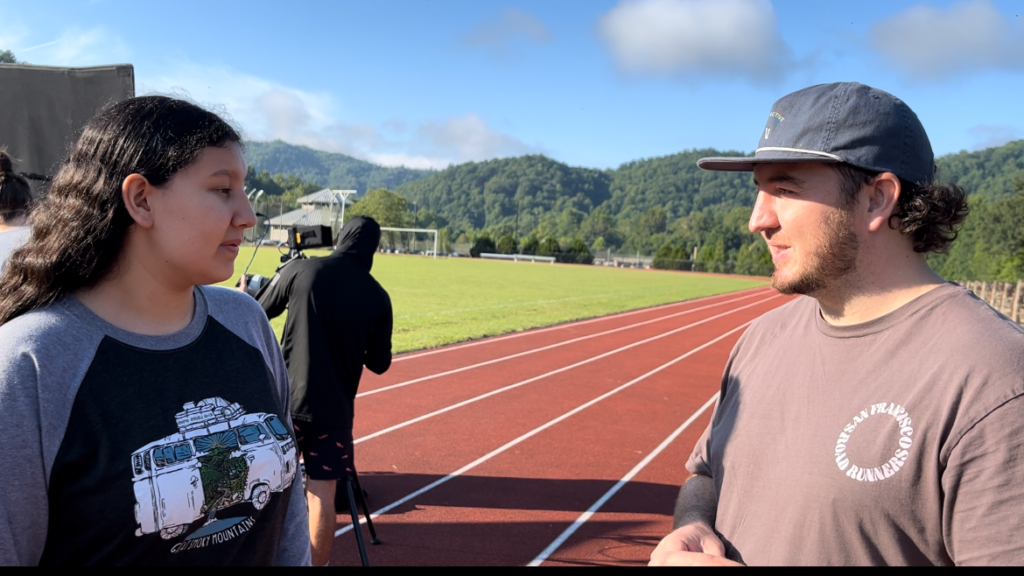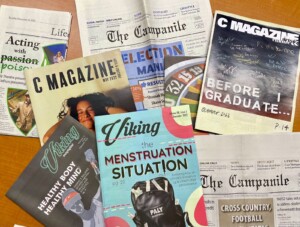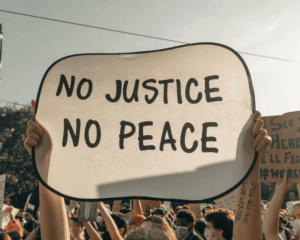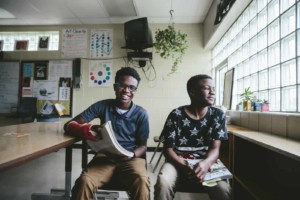Students Are Still Telling the Stories
Key Points
-
Empowering students to engage in their own culture is a great way to help them identify purposeful work.
-
Leveraging community assets like local journalism and broadcasting professionals helps students identify skills and opportunities in possible pathways.

By Chris Wilmoth
Osda Shunale Niagada! O-shi-no-tsi-gv-go-wa-ta!
This familiar refrain meaning, “good morning everyone” and “good to see you”, routinely plays throughout the halls of Cherokee High School in Cherokee, North Carolina. Here, mornings are busy. Before the lesson begins, students must record the announcements, create their news backgrounds and videos, upload them into the iMovie roll and distribute them across the campus. Although I supervise this process, this project is one of many that the students are in full control of. In this Broadcast Journalism class, it is far more than just daily announcements. Rather, the class centers on the development of student responsibility, student creativity, student leadership, and Cherokee culture.

Crafting the Story
In this class, students are learning about the process of news broadcasting. Freshman, Chaz states, “This class I’m taking, it’s not an ordinary class. It involves a lot of moving parts, like setting up equipment, making green screens and backgrounds for those green screens.” Like professional journalists, these students know they are responsible for daily deadlines and for getting the news out in a way that is appealing and resonant. They learn how to turn information into news that their classmates care about.
Chaz continues, “ We have learned subjects such as news vocabulary, like “proximity” which are newsworthy events going on close to you, or “impact” which is when the news is impactful to the viewer.” But more than that, these students are learning the authentic purpose of sharing and receiving stories. Student Noqwisi states, “ I had to take responsibility for what I was given to handle like, making sure the audio is at the correct level, producing the green screen video and making sure we looked realistic and the video was uploaded to the right file. We have been responsible for the whole process from beginning to end even if the teacher has to be out for some reason.”
The class has also given students an opportunity to develop their personalities through news broadcasting. Noqwisi continues, “It helps if someone is shy or isn’t loud or doesn’t talk much, it helps people open up because then they get used to talking more and speaking up and getting used to being on camera.” These skills transfer over to other classes that Noqwisi engages in, as evidenced in her stage acting in the school’s theater department. Noqwisi reflects on this complementary effect, “ I was a very shy person when I first came in, but being in this class helped me, because I had to get in front of a camera and speak with a loud and clear voice, and I have a very soft voice, but after a while, I’ve gotten used to it and now I don’t feel nervous about doing all of that now”
Real-world Opportunities in the Classroom
Students have participated in real-life reporting and on-camera experiences that included creating commercials for a local business, supporting supply procurement for building a recording stage and interviewing school faculty members students need to know more about. Furthermore, they have created video packages for special events such as the Real Life Financial Expo, Career Fairs, and STEM events. To deepen their real-world understanding and connection between the class and the journalism profession, students have also visited local broadcasting studios, hosted a visit from a local weatherman and news journalist, and even interviewed a film crew from the Atlanta Braves professional baseball team, who, at the time, were working on a video package in Cherokee to highlight the partnership between the tribe and the team.
Students have also developed their own leadership by creating tutorials for future classes so that they can learn the news lessons and how to utilize classroom tools such as Do Ink, Google Slides, iMovie and more to create their video packages. They have also been involved in hands-on experiences of learning how to set up and produce interviews, utilize appropriate camera angles for filming, and edit their video packages with software.
Integrating the Cherokee Language and Culture of Storytelling
Most importantly, students are using the class and the acquired broadcasting skills to teach the Cherokee language and continue the cultural tradition of Cherokee storytelling (ka-no-he-tlv-s-gi). Chaz elaborates, “We incorporate our native language into the class. For example, when we are announcing lunch we begin with “the Cherokee word for “I am hungry’ is ‘A-gi-yo-shi-ha’ and we always share the Cherokee word for weather, which is “Do-gal-sdi do-yi-di-tsv-hi?” which means “What is happening outside” and then we give the weather in both Cherokee and English.
The above are just some of the many examples of how students in Broadcast Journalism carry on the timeless craft of the Cherokee in storytelling as well. Cherokee storytellers such as Freeman Owle, who works in the elementary school, and community member John John Toineeta, who share stories at the yearly school pow-wow, continue to proudly tell the legends and myths the Cherokee people have shared for thousands of years. It is a part of the tribe’s identity and the students have heard the stories throughout their childhood. Like these storytellers, these students must know their audience for the video packages they create, and the essential elements of any story worth sharing. What is it that makes this story news and why is it important for the school to hear it?
Students are encouraged to choose stories that are important to them as long as they demonstrate the news with relevance to Cherokee, the tribe, or their concerns. For some, it’s a favorite individual who has influenced their life. Other students have chosen concepts that are important to them such as what it means to be Cherokee or the responsibility of protecting the environment. As mentioned previously, the most recent story the students created was a video package on what goes into making a video project with a freelance film crew hired by the Atlanta Braves to show the ties between the Eastern Band of Cherokee Indians and the major league baseball team. The video package told the story of how the crew got their start in the video production industry and how students interested in video production can begin developing their skills on a smaller scale.
Who are your storytellers? Are you looking for an opportunity to give your students leadership roles in technology? Your students can have the opportunity to tell their own stories and your school’s important news through learning about creating news video packages in Broadcast Journalism. They will learn not just what makes news and why but, more importantly, how they can be a leader in creating and telling the story from start to finish. Osd-ga-she-sti-go-i-ga! (Have a nice day)
Chris Wilmoth is the Instructional Facilitator/Broadcast & Journalism at Cherokee High School.





0 Comments
Leave a Comment
Your email address will not be published. All fields are required.